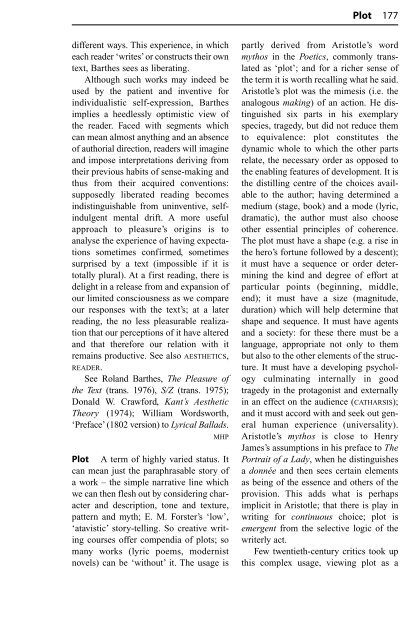The Routledge Dictionary of Literary Terms
The Routledge Dictionary of Literary Terms
The Routledge Dictionary of Literary Terms
Create successful ePaper yourself
Turn your PDF publications into a flip-book with our unique Google optimized e-Paper software.
different ways. This experience, in which<br />
each reader ‘writes’ or constructs their own<br />
text, Barthes sees as liberating.<br />
Although such works may indeed be<br />
used by the patient and inventive for<br />
individualistic self-expression, Barthes<br />
implies a heedlessly optimistic view <strong>of</strong><br />
the reader. Faced with segments which<br />
can mean almost anything and an absence<br />
<strong>of</strong> authorial direction, readers will imagine<br />
and impose interpretations deriving from<br />
their previous habits <strong>of</strong> sense-making and<br />
thus from their acquired conventions:<br />
supposedly liberated reading becomes<br />
indistinguishable from uninventive, selfindulgent<br />
mental drift. A more useful<br />
approach to pleasure’s origins is to<br />
analyse the experience <strong>of</strong> having expectations<br />
sometimes confirmed, sometimes<br />
surprised by a text (impossible if it is<br />
totally plural). At a first reading, there is<br />
delight in a release from and expansion <strong>of</strong><br />
our limited consciousness as we compare<br />
our responses with the text’s; at a later<br />
reading, the no less pleasurable realization<br />
that our perceptions <strong>of</strong> it have altered<br />
and that therefore our relation with it<br />
remains productive. See also AESTHETICS,<br />
READER.<br />
See Roland Barthes, <strong>The</strong> Pleasure <strong>of</strong><br />
the Text (trans. 1976), S/Z (trans. 1975);<br />
Donald W. Crawford, Kant’s Aesthetic<br />
<strong>The</strong>ory (1974); William Wordsworth,<br />
‘Preface’ (1802 version) to Lyrical Ballads.<br />
MHP<br />
Plot A term <strong>of</strong> highly varied status. It<br />
can mean just the paraphrasable story <strong>of</strong><br />
a work – the simple narrative line which<br />
we can then flesh out by considering character<br />
and description, tone and texture,<br />
pattern and myth; E. M. Forster’s ‘low’,<br />
‘atavistic’ story-telling. So creative writing<br />
courses <strong>of</strong>fer compendia <strong>of</strong> plots; so<br />
many works (lyric poems, modernist<br />
novels) can be ‘without’ it. <strong>The</strong> usage is<br />
Plot 177<br />
partly derived from Aristotle’s word<br />
mythos in the Poetics, commonly translated<br />
as ‘plot’; and for a richer sense <strong>of</strong><br />
the term it is worth recalling what he said.<br />
Aristotle’s plot was the mimesis (i.e. the<br />
analogous making) <strong>of</strong> an action. He distinguished<br />
six parts in his exemplary<br />
species, tragedy, but did not reduce them<br />
to equivalence: plot constitutes the<br />
dynamic whole to which the other parts<br />
relate, the necessary order as opposed to<br />
the enabling features <strong>of</strong> development. It is<br />
the distilling centre <strong>of</strong> the choices available<br />
to the author; having determined a<br />
medium (stage, book) and a mode (lyric,<br />
dramatic), the author must also choose<br />
other essential principles <strong>of</strong> coherence.<br />
<strong>The</strong> plot must have a shape (e.g. a rise in<br />
the hero’s fortune followed by a descent);<br />
it must have a sequence or order determining<br />
the kind and degree <strong>of</strong> effort at<br />
particular points (beginning, middle,<br />
end); it must have a size (magnitude,<br />
duration) which will help determine that<br />
shape and sequence. It must have agents<br />
and a society: for these there must be a<br />
language, appropriate not only to them<br />
but also to the other elements <strong>of</strong> the structure.<br />
It must have a developing psychology<br />
culminating internally in good<br />
tragedy in the protagonist and externally<br />
in an effect on the audience (CATHARSIS);<br />
and it must accord with and seek out general<br />
human experience (universality).<br />
Aristotle’s mythos is close to Henry<br />
James’s assumptions in his preface to <strong>The</strong><br />
Portrait <strong>of</strong> a Lady, when he distinguishes<br />
a donnée and then sees certain elements<br />
as being <strong>of</strong> the essence and others <strong>of</strong> the<br />
provision. This adds what is perhaps<br />
implicit in Aristotle; that there is play in<br />
writing for continuous choice; plot is<br />
emergent from the selective logic <strong>of</strong> the<br />
writerly act.<br />
Few twentieth-century critics took up<br />
this complex usage, viewing plot as a

















